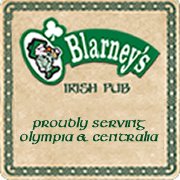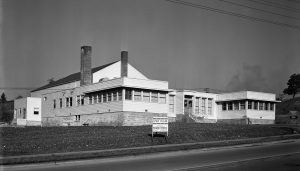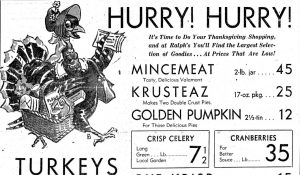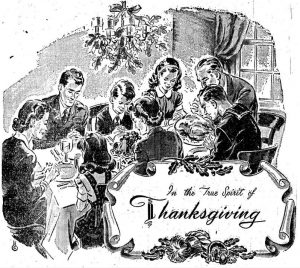For many people, Thanksgiving is a special celebration, full of traditions and happy memories. During World War II – 1941-1945 for the U.S. – Thanksgiving became seen as emblematic of everything America was fighting for.
 Long celebrated in New England, Thanksgiving became a national holiday in 1863. In 1939, President Franklin Roosevelt moved Thanksgiving from the last Thursday to the fourth Thursday in November to boost Christmas shopping in an attempt to help the country’s still struggling economy.
Long celebrated in New England, Thanksgiving became a national holiday in 1863. In 1939, President Franklin Roosevelt moved Thanksgiving from the last Thursday to the fourth Thursday in November to boost Christmas shopping in an attempt to help the country’s still struggling economy.
Thanksgiving On the Eve of War in Olympia
War clouds were on the horizon when people set down to their turkey dinners in 1941. Even those who attended a special Thanksgiving show at the Avalon Theater – Gene Autry’s “Down Mexico Way” – could not escape the shadows of the world conflict.
Fort Lewis (now JBLM) was beginning to build up its forces and Olympia tried to cheer visiting soldiers at the Army-Navy Club, located in the Old State Capitol Building. The Minute Women, a World War I service organization, kept a cookie jar filled for them. In the weekend after the holiday, women from Littlerock and Rochester baked 40 dozen batches of sugary goodness.

Just a month later, the United States officially entered World War II after the attack on Pearl Harbor. World War II Thanksgivings would be characterized by rationing and separation from loved ones and home, both for soldiers and Japanese Americans forced into internment camps.
Dealing with Rationing for Thanksgiving
People sought ways in the wartime years to adapt holiday traditions to rationing restrictions and shortages, saving up ration points for the big day. While propaganda emphasized prosperity and abundance, people were also urged to make small sacrifices during this crisis. An advertisement, sponsored by local businesses, printed in the Daily Olympian on November 25, 1943, urged people to produce, conserve, share and “play square” with their food. The accompanying image showed the story of shipwrecked sailors in the Atlantic trying to catch a seagull to eat on Thanksgiving the year before.
Local newspapers were full of practical advice. “Don’t slave over the Thanksgiving dessert,” advised a November 18, 1943 column, “It’s neither necessary nor good form in wartime. But make dessert good to eat and good to look at—also easy on ration points.” The writer suggested replacing pumpkin pie with “marble pie,” made with instant chocolate and vanilla pudding.

Beulah Fewless, home service consultant for the Puget Power and Light Company, set up a Thanksgiving table at their headquarters in 1943. As guests nibbled on rolled sandwiches and sipped coffee or cider, they could ask questions and take free “up-to-the-minute” recipe booklets. Holiday traditions were precious, she argued, and friendship was not rationed.
Gas rationing made dining out on Thanksgiving impractical. Nor could restaurants escape rising costs. A full course Thanksgiving dinner at the Chicken Coop in Tumwater (later the South Pacific Restaurant) cost 75 cents in 1941, a dollar in 1942 and a whopping $1.25 in 1944.
Thanksgiving Community Celebrations
But despite wartime obstacles, people still found a way to come together and celebrate. Many churches held special Thanksgiving services. Olympia High School’s Hi-Yi YMCA club sponsored an annual ecumenical Thanksgiving service in the school’s auditorium. Organized by local churches and Temple Beth Hatfiloh, its wartime services raised money to aid prisoners of war. A chorus of 30 servicemen performed in 1944.
Football was another way people came together. Olympia High School played on Thanksgiving but soldiers also got in the spirit of the holiday. The Fort Lewis Medics beat the Engineers 27 to 6 at Stevens Field on Thanksgiving Day 1944. This game, sponsored by local service and fraternal organizations, raised over $2,500 to pay for phone calls for patients at Madigan Hospital.
Olympia USO Thanksgiving
After the war began, the servicemembers club became a USO. A dedicated building was built in 1942, but was destroyed by fire. Its replacement later became the Olympia Community Center, though it has since been demolished.

Wherever its location, the USO held annual Thanksgiving parties. Volunteers decorated the clubhouse with a harvest theme. The day started with games and popcorn popped fresh in the club’s fireplace. A buffet turkey supper was available in the evening, followed by a dance with live music and a quiz contest that pitted soldiers against the junior hostesses. The door prize in 1945 was a free phone call home.
In 1943 over 100 servicemen and women and their families came to the celebration at the clubhouse. The Army Mothers’ Club, which sponsored the party that year, served 6, 25-pound turkeys along with the regular spread. They were glad to take time from their own family celebrations to help soldiers far from home on the holiday. “While we are doing this for the boys stationed near here,” said Mrs. M.F. Fisher, chair of table decorations, “someone else will be doing as much for our sons elsewhere.”
While most soldiers in the Olympia area were too far away to get leave to go home for the holiday, soldiers could still get a homecooked family meal. People who wanted to invite a soldier to dinner could contact the USO.
Peace
Thanksgiving 1945 was a happy one as people celebrated the coming of peace. Most soldiers were unable to return for the holiday that year but that did not stop Olympia’s Joe Baker from celebrating Thanksgiving nearly a month late when his son Clyde returned home from the Pacific. His ship had docked in Tacoma and he had gotten leave. It was also his father’s birthday. Although the hardships of World War II cast a shadow over the celebration, this Thanksgiving proved to be the best holiday the Baker family and so many others had ever had.



















































